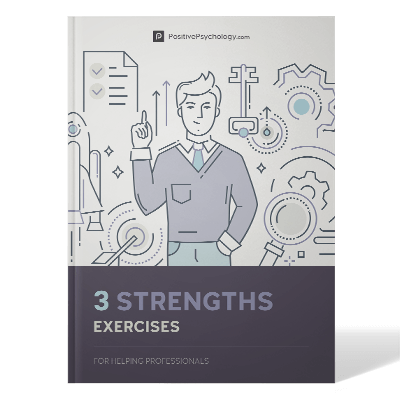Intuition Training: 5 Exercises to Strengthen Intuition
 What made you decide to read this article?
What made you decide to read this article?
Perhaps you saw the title and just had a gut feeling that it would prove useful to you.
We often make these sorts of quick decisions, without a lengthy analytic process, guided by our intuition. Until recently, there was little compelling scientific evidence supporting the very existence of intuition.
Lufityanto, Donkin, and Pearson (2016) aimed to address this, conducting experiments that found that nonconscious emotional information can boost decision accuracy and speed up response times.
If using our intuition can be a helpful way to make decisions, is there anything we can do to develop or improve our intuitive process, or is this just a superpower some individuals possess?
This article will look at whether intuition can be learned, suggest some ways to develop our intuition, and potentially help our clients do the same.
Before you continue, we thought you might like to download our three Strengths Exercises for free. These detailed, science-based exercises will help you or your clients realize your unique potential and create a life that feels energized and authentic.
This Article Contains:
Can Intuition Be Learned?
Over recent years, this topic has garnered interest in various fields, with many websites and bestselling books extolling the virtues of tuning into our intuitive processing and using it to guide decision making.
However, scientific research in the area is still relatively limited, and it can be challenging to establish the hard facts.
While differing definitions of intuition abound, it is common to understand that it is a form of information processing distinct from analytical reasoning.
Daniel Kahneman, in his book Thinking, Fast and Slow (2011), expands on psychological research that distinguishes between System 1, which is automatic and quick (intuition), and System 2, which is slower and involves deliberate and effortful mental activities.
Decision making is likely to be most effective when we utilize both systems. This is particularly true in unfamiliar and high-stakes decisions. But while there is no doubt we can improve our analytical thought processes, is the same true for our intuition?
There is general consensus that intuitive processing is an innate process (e.g., Kahneman, 2011), but nonetheless, many working in the field suggest that it can be developed and improved upon.
Your intuitive learning systems are always operating and accumulating information and beliefs, mostly without conscious awareness (Hogarth, 2008).
To this end, one way to develop intuition is to actively seek out environments that provide desirable learning opportunities (Hogarth, 2008). Examples of this might be attending seminars and conferences as part of continued professional development or a placement rotation in a professional setting.
An area of particular relevance to therapists is social intuition, which involves making (largely nonconscious) decisions about others’ emotions, attitudes, and intentions (Lieberman, 2000).
Nonverbal decoding, or the reading of body language, plays a vital role in intuitive processing. Not only do we read other people’s nonverbal cues to make judgments, but we are also constantly communicating our own internal state, usually without conscious attention.
The skill of social intuition improves from childhood to adulthood (Lieberman, 2000), which indicates that it can be learned. As with other skills, the suggested route to improvement is paying attention, practice, and reflection (Gore & Sadler-Smith, 2011).
Once more, we should exercise caution; while intuitive social judgments can be accurate, they are also prone to errors and biases (Kahneman & Frederick, 2005). For more on that, read our article on cognitive biases.
5 Helpful Exercises

Although to be clear, there is little scientific evidence currently available to verify their utility.
1. Prioritize your intuition
Today we live in a world where we are constantly bombarded by data. When you add into the mix the fact that modernism prizes a focus on rationality and science, it is understandable that it can be hard to listen to our intuition and just let it flow.
According to some of those writing on the topic, this is exactly what we need to do. You need to recognize that intuitive processing can help decision making, and allow time and space for answers to come to you without overanalyzing a situation.
Make time each day, or even several times a day if you have an important decision to make, to tune into your intuition.
2. Get to know how your intuition ‘speaks’ to you
People experience intuition differently. For some, it may manifest as an image; for others, as a physical sensation (the classic ‘gut feeling’); yet others identify a more emotional response. Slow down and try to sense how, or where, you experience your intuitions.
3. Keep a reflective journal
Try writing down your hunches in a journal and notice how they are experienced. This is particularly beneficial if you can capture them before the analytic process takes over.
For this reason, it might be helpful to keep the journal with you during the day. Making a note of your gut feelings about a situation or decision also means you can check them later, to assess how accurate or helpful they were.
Writing down words and phrases as they come to you when considering a problem may also provide you with a different insight. As an alternative or complementary approach, it can be useful to draw pictures or doodles. Drawing tends to slow us down and may tap into more intuitive modes of thinking.
4. Employ mindfulness techniques
Mindfulness encourages us to notice feelings and thoughts without attaching to them. This can be particularly useful if you are trying to develop your intuition. Watching and accepting thoughts without judgment will allow you greater access to intuitive information.
Another useful mindfulness technique, the body scan, can help you notice sensations in your body, which might relate to intuitive processing. A body scan can be done whenever you have an important decision to make or practiced daily to improve intuition.
Being present and mindful of our surroundings is also likely to help develop intuition, by providing the unconscious with rich data to inform decisions.
5. Make a note of your dreams
For the final technique, I turn to Freud himself, who famously said:
The interpretation of dreams is the royal road to a knowledge of the mind’s unconscious activities.
Dreams can provide us with a wealth of information about our unconscious processes. Writing them down upon waking will aid with recall, and the content can be explored to give clues to any difficulties or dilemmas you might be facing.
7 Questions to Help Develop Your Clients’ Intuition
The techniques outlined above can all be used with clients and to develop your own intuition, and can provide useful fodder for therapy sessions.
Some questions that might help clients access and develop their intuition are as follows:
- “Does it feel like the right thing to do?”
- “Does it seem like the right answer?”
- “How do you feel when you think about x situation?”
- “What was your gut reaction?”
- “Do you have a hunch about that?”
- “Where in your body do you notice a reaction?”
- “If you did know the answer, what would it be?”
A Look at An Intuition Game
National Geographic, as part of their Brain Games series, has produced ‘The Intuition Game,’ which provides a fun way to explore and explain intuition.

Available for Android users.
Assessing Intuition: Three Valuable Tests
There are numerous pop-quiz style tests available on the internet that claim to assess or measure your intuitive capacity. For obvious reasons, I have steered clear of these and looked at some of the most well-utilized and most scientifically valid intuition measures.
1. The Types of Intuition Scale
The Types of Intuition Scale (Pretz et al., 2014) is based on the theory that there are three distinct types of intuition (Pretz & Totz, 2007):
- holistic
- inferential
- affective
The measure assesses all three types in one questionnaire. Previous efforts had failed to differentiate between these different constructs.
You can access the scale questionnaire on page 3 of this PDF.
2. The Rational Experiential Inventory
The Rational Experiential Inventory (Pacini & Epstein, 1999) is a self-report instrument designed to assess individual differences in thinking style. It measures the degree to which people report they have intuitive or rational/analytical thinking styles.
This instrument has been subjected to rigorous testing and has been shown to have structural validity and satisfactory psychometric properties (e.g., Björklund & Bäckström, 2008).
The questionnaire can be accessed here.
3. Myers-Briggs Type Indicator
The most well-known of the tests that purport to measure intuition is the Myers-Briggs Type Indicator (MBTI; Myers, McCaulley, Quenk, & Hammer, 1998). The MBTI is the most widely used personality test globally, and over two million people complete it annually, usually in corporate settings.
The four scales (extraversion–introversion, sensing–intuition, thinking–feeling, and judging–perceiving) are based on Carl Jung’s theory of personality types.
However, despite its widespread appeal and utility, criticisms have been levied, and researchers have demonstrated that the MBTI does not meet rigorous theoretical criteria. It lacks testability and has internal contradictions (Stein & Swan, 2019).
PositivePsychology.com Tools
The Connecting to Your Intuition tool in the Positive Psychology Toolkit© provides further helpful ideas for connecting with your intuition.
The goal of the exercise is to establish consistent confidence in connecting with your intuition. The exercise utilizes mindful and heart-focused psychophysiological coherence building. Clients can then learn to pay closer attention to their intuitive sensations and be more confident in their choices.
This introductory article to intuition and why it is important is also a good read.
If you’re looking for more science-based ways to help others develop their strengths, this collection contains 17 strength-finding tools for practitioners. Use them to help others better understand and harness their strengths in life-enhancing ways.
A Take-Home Message
Intuition is a natural process, and it is widely agreed that we all have some inherent intuitive ability.
When we harness and apply intuition, we can make decisions faster and more comfortably.
However, it is important not to overestimate the accuracy of intuitive decisions. Most experts agree that while unconscious processes play an important role, decision making is most effective when both analytical and intuitive reasoning are employed together.
While the topic of intuition has garnered much interest in popular culture, psychological research in the area is somewhat limited. This means we should approach both the most popular assessment methods and the suggestions for developing intuition with some healthy skepticism.
Nonetheless, there would appear to be advantages in taking time to understand our intuitive processes better and encourage clients to hone theirs.
We hope you enjoyed reading this article. Don’t forget to download our three Strengths Exercises for free.
- Björklund, F., & Bäckström, M. (2008). Individual differences in processing styles: Validity of the Rational–Experiential Inventory. Scandinavian Journal of Psychology, 49(5), 439–446.
- Epstein, S. (2010). Demystifying intuition: What it is, what it does, and how it does it. Psychological Inquiry, 21(4), 295–312.
- Gore, J., & Sadler-Smith, E. (2011). Unpacking intuition: A process and outcome framework. Review of General Psychology, 15(4), 304–316.
- Hogarth, R. (2008). On the learning of intuition. In H. Plessner, C. Betch, & T. Betch (Eds.), Intuition in judgment and decision making (pp. 91–105). New Jersey: Lawrence Erlbaum Associates.
- Kahneman, D. (2011). Thinking, fast and slow. New York: Farrar, Straus and Giroux.
- Kahneman, D., & Frederick, S. (2005). A model of heuristic judgment. In K. Holyoak, & R.G. Morrison (Eds). The Cambridge handbook of thinking and reasoning (pp. 267–294). New York: Cambridge University Press.
- Lieberman, M. D. (2000). Intuition: A social cognitive neuroscience approach. Psychological Bulletin, 126(1), 109.
- Lufityanto, G., Donkin, C., & Pearson, J. (2016). Measuring intuition: Nonconscious emotional information boosts decision accuracy and confidence. Psychological Science, 27(5), 622–634
- Myers, I., McCaulley, M. H., Quenk, N. L., & Hammer, A. L. (1998). Manual: A guide to the development and use of the Myers–Briggs Type Indicator (2nd ed.). Palo Alto, CA: Consulting Psychologists Press.
- Pacini, R., & Epstein, S. (1999). The relation of rational and experiential information processing styles to personality, basic beliefs, and the ratio-bias phenomenon. Journal of Personality and Social Psychology, 76, 972–987.
- Pretz, J. E., Brookings, J. B., Carlson, L. A., Humbert, T. K., Roy, M., Jones, M., & Memmert, D. (2014). Development and validation of a new measure of intuition: The types of intuition scale. Journal of Behavioral Decision Making, 27(5), 454–467.
- Pretz, J. E., & Totz, K. S. (2007). Measuring individual differences in affective, heuristic, and holistic intuition. Personality and Individual Differences, 43, 1247–1257.
- Stein, R., & Swan, A. B. (2019). Evaluating the validity of Myers-Briggs Type Indicator theory: A teaching tool and window into intuitive psychology. Social and Personality Psychology Compass, 13(2).
Let us know your thoughts
Read other articles by their category
- Body & Brain (49)
- Coaching & Application (57)
- Compassion (26)
- Counseling (51)
- Emotional Intelligence (24)
- Gratitude (18)
- Grief & Bereavement (21)
- Happiness & SWB (40)
- Meaning & Values (26)
- Meditation (20)
- Mindfulness (45)
- Motivation & Goals (45)
- Optimism & Mindset (34)
- Positive CBT (28)
- Positive Communication (20)
- Positive Education (47)
- Positive Emotions (32)
- Positive Leadership (18)
- Positive Parenting (4)
- Positive Psychology (33)
- Positive Workplace (37)
- Productivity (16)
- Relationships (46)
- Resilience & Coping (36)
- Self Awareness (21)
- Self Esteem (37)
- Strengths & Virtues (31)
- Stress & Burnout Prevention (34)
- Theory & Books (46)
- Therapy Exercises (37)
- Types of Therapy (64)




What our readers think
Excellent guide. Wish to discuss with you.